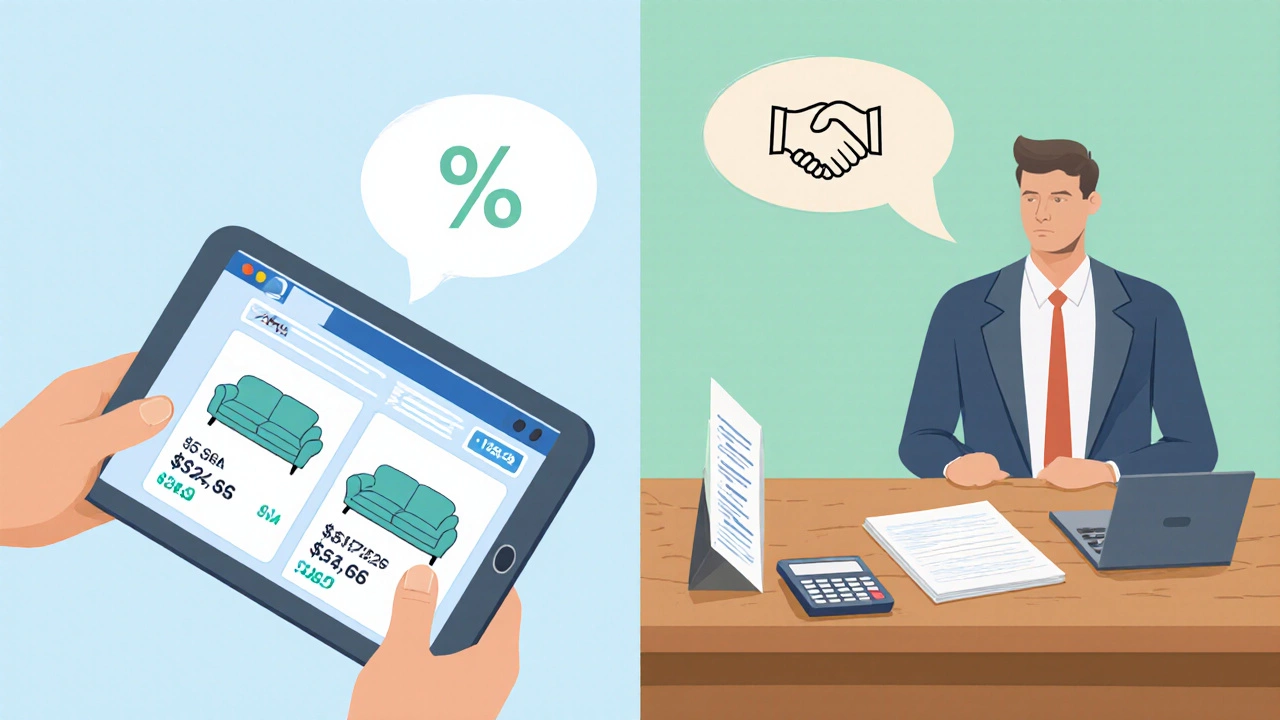Furniture Haggle Calculator
Your Negotiation Estimate
Recommended Tactics
Ever walked into a showroom, fallen in love with a Furniture is a broad category of movable objects-like sofas, tables, and wardrobes-that furnish a home or office. and left wondering if you could have paid less? You’re not alone. Below you’ll find everything you need to decide whether to haggle, where it works best, and how to get a genuine discount without feeling awkward.
Why the Idea of Haggle Still Matters
In an era of online price‑match guarantees, the notion of bargaining might feel outdated. Yet, many brick‑and‑mortar Retailer stores that sell furniture and often have flexible pricing policies still leave room on the table, especially during slow sales periods. A successful negotiation can shave off 5‑20% of the sticker price, turning a good deal into a great one.
When Is It Worth Trying to Haggle?
- Big‑ticket items - sofas, dining sets, and bedroom suites often carry a higher margin, giving sales staff leeway.
- End‑of‑season sales - stores are eager to clear inventory, so they’re more receptive to price cuts.
- Local, independent shops - owners usually control pricing directly and prefer to keep customers happy.
- Custom orders - when you choose fabric, finish, or dimensions, you can negotiate add‑on costs.
If you’re buying a low‑cost side table from a big‑box chain that advertises “everyday low prices,” the odds of a meaningful discount drop dramatically.

Prep Work: Research, Numbers, and Confidence
Before you even set foot in the showroom, gather three key pieces of data:
- Market price - Check the same item on at least two Online Marketplace websites like Amazon, Wayfair, or local classifieds where furniture is sold. Note the average cost.
- Current promotions - Look for seasonal sales, clearance tags, or manufacturer rebates that might already be applied.
- Store policy - Some outlets publish a “price‑match” or “discount‑policy” page. Knowing the official stance helps frame your request.
Armed with numbers, you can say, “I saw this same sofa for $800 online; can you meet that price?” The precise figure shows you’ve done your homework and makes the salesperson more likely to respond positively.
Effective Negotiation Tactics
Below are proven moves that keep the conversation friendly and productive:
- Start low, but realistic - Offer 10‑15% less than the listed price. It gives you room to meet halfway.
- Bundle for a discount - If you need a coffee table and a rug, ask for a package price.
- Ask about floor‑model availability - Display pieces often have minor wear and can be sold at a reduced rate.
- Leverage delivery fees - If the store charges for delivery, negotiate that cost down or ask for it to be waived in exchange for a lower furniture price.
- Show willingness to walk away - Politely say you’ll keep looking elsewhere if the price can’t move. Many salespeople will rethink their stance.
Remember, the goal is a win‑win. You want the Customer person buying furniture who seeks value and a pleasant shopping experience to feel good about the purchase, and the retailer to keep the sale.
Where to Haggle: Retailer Types Compared
| Retailer Type | Typical Pricing Policy | Best Tactics | Example Stores |
|---|---|---|---|
| Independent Furniture Shop | Flexible, owner‑set prices | Bundle, floor‑model, cash discount | Local boutique in Birmingham |
| Mid‑range Chain (e.g., DFS, IKEA) | Mixed - some negotiable items | End‑of‑season, bulk‑order, delivery fee | DFS, Furniture Village |
| Big‑Box Discount Store | Fixed “everyday low price” | Check price‑match, look for clearance | Argos, Walmart |
| Online‑only Retailer | Transparent pricing, limited haggling | Apply coupon codes, wait for sales events | Wayfair, Amazon |
Knowing the environment helps you pick the right approach. Independent shops give you the most latitude, whereas big‑box stores often only respond to clear‑cut promotions.

Pitfalls to Avoid
- Being overly aggressive - Raising your voice or demanding a discount can backfire, especially in upscale showrooms.
- Ignoring hidden costs - A lower sticker price might hide higher delivery or assembly fees. Ask for a full cost breakdown.
- Negotiating after checkout - Once you’ve signed the receipt, most retailers won’t revisit the price.
- Assuming every item is negotiable - Clearance items are often already at their lowest possible price.
If you keep the tone courteous and focus on the overall value, you’ll stay on the retailer’s good side and increase the chances of a successful outcome.
Quick Checklist Before You Walk In
- Know the average market price for the exact model.
- Identify any active promotions or rebates.
- Decide on a target discount (e.g., 12%).
- Prepare a polite opening line: “I love this piece; could we discuss the price?”
- Bring a copy of competitor pricing or a screenshot on your phone.
- Be ready to walk away if the offer doesn’t meet your target.
Follow these steps, and you’ll walk out with a deal that feels earned.
Mini‑FAQ
Is it rude to ask for a discount on furniture?
Not at all, as long as you stay polite and frame the request as a discussion. Most salespeople expect price talk, especially on higher‑priced items.
Can I haggle on furniture bought online?
Direct haggling is rare online, but you can use coupon codes, wait for flash sales, or contact customer service to ask about price matches or upcoming promotions.
What’s the best time of year to negotiate furniture prices?
Late summer, end‑of‑financial‑year (June/July), and post‑Christmas clearance periods usually see the deepest discounts.
Should I bring cash to get a better deal?
Many retailers appreciate cash because it avoids processing fees. Politely ask if a cash discount is available; you might save an extra 1‑2%.
How do I handle delivery fees during negotiation?
Treat delivery as a separate line item. Ask for it to be waived or included in the overall discount. Some shops will drop the fee if you agree to a higher purchase total.
Whether you’re eyeing a sleek sofa or a sturdy wardrobe, remembering these tips turns the usual shopping trip into a strategic, confidence‑boosting experience. The next time you step into a showroom, ask yourself: "Can I get a better price?" and then put the plan into action.


Write a comment